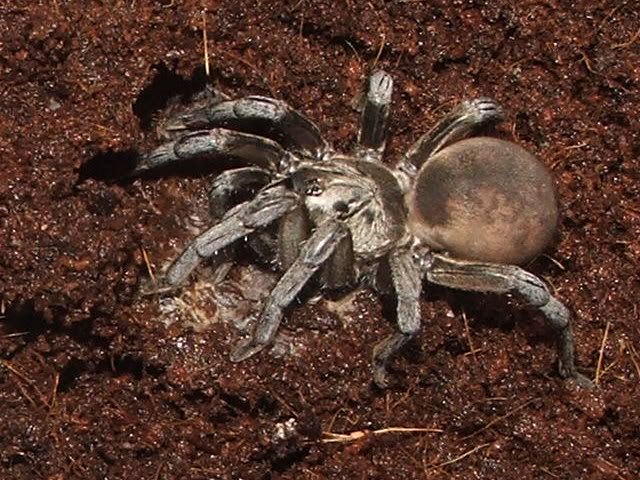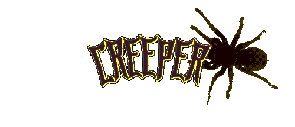Post by Creeper on Apr 30, 2015 8:47:27 GMT 5
African Trapdoor Spider - Ctenolophus spp.

Scientific classification
Kingdom: Animalia
Phylum: Arthropoda
Class: Arachnida
Order: Araneae
Family: Idiopidae
Genus: Ctenolophus
Species:
Ctenolophus cregoei (Purcell, 1902) — South Africa
Ctenolophus fenoulheti Hewitt, 1913 — South Africa
Ctenolophus heligmomeriformis Strand, 1907 — South Africa
Ctenolophus kolbei (Purcell, 1902) — South Africa
Ctenolophus oomi Hewitt, 1913 — South Africa
Ctenolophus pectinipalpis (Purcell, 1903) — South Africa
Ctenolophus spiricola (Purcell, 1903) — South Africa
The African Trapdoor Spider is a grossly understudied genus of mygalomorphic spider of the Idiopidae Family, native to Southern Africa. This genus is fairly popular in the pet trade listed by color (red, black and silver.)

Red

Black

Silver

Description
Members of this genera are some of the largest representative of trapdoor spiders, females may grow up to 2" (5 cm) in body length with a leg span that can reach about 3" (7 cm.) Males have a similar leg span but are generally less massive. The body is scantily covered with fine hairs. Males are more brightly colored than females.
Females may live up to 10 years in captivity while males will only live about a year beyond reaching maturity (ultimate molt.)
The venom of African Trapdoor Spiders has not been fully investigated but hobbyist equate it to the venom of baboon spiders.

Behavior
Like most trapdoor spiders they are largely fossorial, digging a burrow a minimum of 6" (15 cm) heavily lined with silk. Females will spend their entire lives within close proximity to the burrow while males can be observed to wandering in search of a mate upon reaching maturity. The burrow is disguised with a hinged trapdoor that gives these spiders their name sake, the door is camouflaged with soil and leaf litter. The spider will lay webbing near the entrance and await the vibrations of potential prey, usually terrestrial insects. Prey will be seized, evenomated and pulled into the burrow for consumption.

References
Baboon and Trapdoor Spiders of Southern Africa: An Identification Manual
Idiopidae (Trapdoor Spider) Care
African Trapdoor Spider Care

Scientific classification
Kingdom: Animalia
Phylum: Arthropoda
Class: Arachnida
Order: Araneae
Family: Idiopidae
Genus: Ctenolophus
Species:
Ctenolophus cregoei (Purcell, 1902) — South Africa
Ctenolophus fenoulheti Hewitt, 1913 — South Africa
Ctenolophus heligmomeriformis Strand, 1907 — South Africa
Ctenolophus kolbei (Purcell, 1902) — South Africa
Ctenolophus oomi Hewitt, 1913 — South Africa
Ctenolophus pectinipalpis (Purcell, 1903) — South Africa
Ctenolophus spiricola (Purcell, 1903) — South Africa
The African Trapdoor Spider is a grossly understudied genus of mygalomorphic spider of the Idiopidae Family, native to Southern Africa. This genus is fairly popular in the pet trade listed by color (red, black and silver.)

Red

Black

Silver
Description
Members of this genera are some of the largest representative of trapdoor spiders, females may grow up to 2" (5 cm) in body length with a leg span that can reach about 3" (7 cm.) Males have a similar leg span but are generally less massive. The body is scantily covered with fine hairs. Males are more brightly colored than females.
Females may live up to 10 years in captivity while males will only live about a year beyond reaching maturity (ultimate molt.)
The venom of African Trapdoor Spiders has not been fully investigated but hobbyist equate it to the venom of baboon spiders.
Behavior
Like most trapdoor spiders they are largely fossorial, digging a burrow a minimum of 6" (15 cm) heavily lined with silk. Females will spend their entire lives within close proximity to the burrow while males can be observed to wandering in search of a mate upon reaching maturity. The burrow is disguised with a hinged trapdoor that gives these spiders their name sake, the door is camouflaged with soil and leaf litter. The spider will lay webbing near the entrance and await the vibrations of potential prey, usually terrestrial insects. Prey will be seized, evenomated and pulled into the burrow for consumption.

References
Baboon and Trapdoor Spiders of Southern Africa: An Identification Manual
Idiopidae (Trapdoor Spider) Care
African Trapdoor Spider Care


